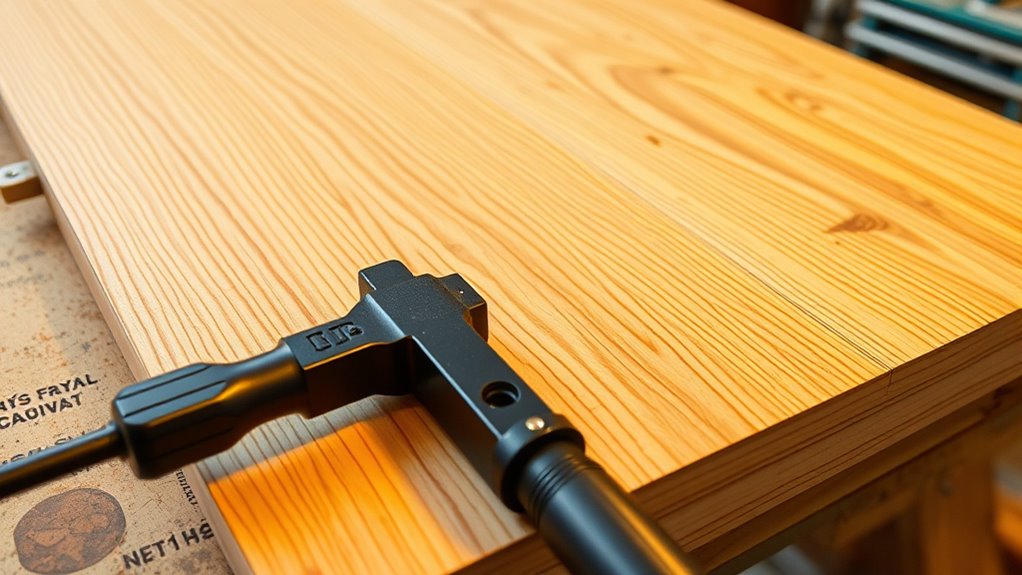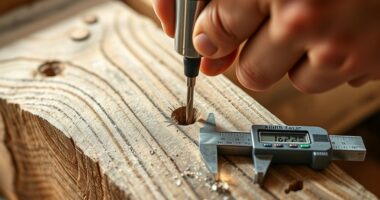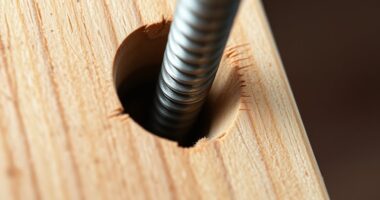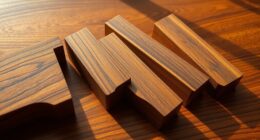To eliminate panel bowing forever, focus on applying the right clamp pressure—not too tight, not too loose. Carefully position your clamps and tighten them gradually in small steps, checking the surface as you go. Use wide, smooth jaws or add a caul to distribute pressure evenly across the panel. Mastering this simple technique guarantees flat, stable panels every time—keep following for more expert tips to perfect your clamping process.
Key Takeaways
- Use a single, wide clamp with a caul to distribute pressure evenly across the panel.
- Gradually tighten the clamp in small increments, checking for flatness after each adjustment.
- Calibrate clamp force based on material type to prevent over-tightening and warping.
- Place a flat, smooth caul or scrap wood between the clamp and panel for delicate surfaces.
- Test and refine your technique with scrap pieces to find the optimal pressure for your materials.
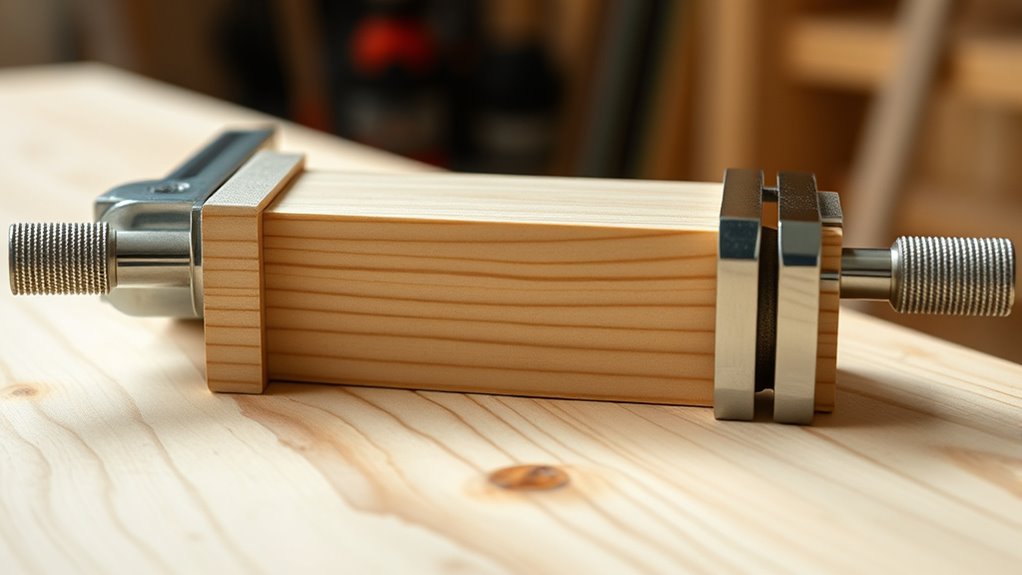
Have you ever struggled to secure a workpiece or hold something in place while working? If so, you’re not alone. Many DIYers and professionals face this challenge, especially when dealing with panels that tend to bow or warp under pressure. The key to overcoming this problem lies in mastering a simple but powerful clamp trick that guarantees consistent results every time. This trick revolves around controlling clamp pressure to achieve perfect panel consistency, eliminating the frustrating issue of panel bowing once and for all.
When you clamp a panel, the goal is to hold it firmly without causing deformation. Too much clamp pressure can squeeze the material unevenly, creating unwanted bowing or warping. Too little, and the panel won’t stay in place, making your work unstable and prone to shifting. The trick is to find that sweet spot where the clamp pressure is just enough to hold the panel securely without compromising its flatness. You want to apply enough force to keep the panel flat, but not so much that it causes the material to bend or distort. This balance is essential for achieving panel consistency, which directly impacts the quality of your final project.
Find the perfect clamp pressure to hold panels flat without causing warping or shifting.
To do this effectively, start by positioning your clamp carefully and tightening it gradually. Instead of cranking down all at once, tighten the clamp in small increments, checking the panel’s surface after each adjustment. This allows you to gauge the right amount of pressure needed. Using a scrap piece or a test panel beforehand helps you calibrate your clamp pressure, so you know exactly how much force is appropriate for your specific material. Once you get that feeling, you’ll develop a sense of how tightly to clamp without risking panel distortion. Additionally, understanding the importance of proper clamp pressure can help you avoid common issues like panel warping and achieve more professional results.
Another tip is to use the right type of clamp for the job. F-style clamps or bar clamps with a wide, smooth jaw surface distribute pressure more evenly, reducing the risk of creating bowing or uneven panel thickness. If you’re working with delicate or thin panels, consider adding a caul or a flat piece of scrap wood between the clamp and the panel. This spreads out the clamp pressure evenly, ensuring consistent contact and preventing localized bowing.
In the end, this one clamp trick—focusing on proper clamp pressure—will transform your work process. It guarantees panel consistency and eliminates the common problem of panel bowing. With patience and practice, you’ll learn how to control the force perfectly, resulting in flat, professional-looking panels every time. It’s a simple adjustment that makes a huge difference, saving you time, frustration, and material waste in the long run.
Frequently Asked Questions
Can This Clamp Trick Be Used on Different Panel Materials?
You wonder if this clamp trick works on different panel materials. It generally depends on clamp durability and material compatibility. For sturdy materials like metal or thick plywood, the clamp holds well without damage. However, softer or more delicate materials may require gentler clamps to avoid warping or cracking. Always check the clamp’s strength and verify it’s compatible with your panel’s material to achieve the best results without risking damage.
How Long Should the Clamp Be Left in Place?
You should leave the clamp in place for the recommended clamp duration, which varies depending on the panel material and adhesive used. Typically, you’ll need to maintain pressure during the curing time specified by the manufacturer—usually around 30 minutes to an hour. Make sure to follow these guidelines closely to guarantee the panel stays flat and the adhesive cures properly, preventing any bowing issues later.
Will This Method Work on Large or Thick Panels?
You might find it’s surprisingly effective on large or thick panels, especially if you pay attention to material compatibility and panel thickness. While the clamp trick works well for many materials, thicker or denser panels may require additional support or thicker clamps. Always test on a small area first, and adapt your approach based on the specific material and panel thickness to guarantee the best results.
Are There Any Safety Precautions to Consider?
When using clamps, you should always prioritize safety. Wear appropriate safety gear like gloves and eye protection to prevent injuries. Confirm your work area is clean and well-organized to avoid accidents. Make sure the clamps are securely fastened and not over-tightened, which could cause damage or slips. Always follow the manufacturer’s instructions, and double-check your setup before applying pressure to avoid any safety hazards.
Can This Technique Prevent Future Panel Bowing?
Think of your panels as a ship’s hull—strong but vulnerable to shifts. This technique can help improve panel durability by evenly distributing pressure, which reduces the risk of future bowing. Proper clamp maintenance is vital; if neglected, the method’s effectiveness fades like a lighthouse in fog. While it offers long-term benefits, regular inspections and adjustments are essential to keep panels straight and prevent future issues.
Conclusion
Now, imagine never worrying about panel bowing again. With this simple clamp trick, you’re about to reveal a secret that many overlook. It’s easy, fast, and surprisingly effective—once you try it, you’ll wonder why you didn’t do it sooner. But here’s the catch: this method isn’t just a quick fix; it’s a game-changer. Ready to see your panels stay perfect forever? The solution’s just one clamp away—are you ready to try it?
